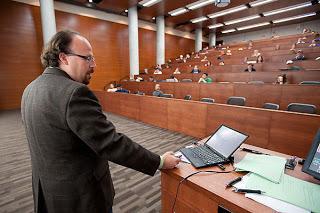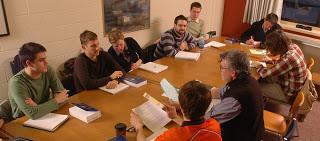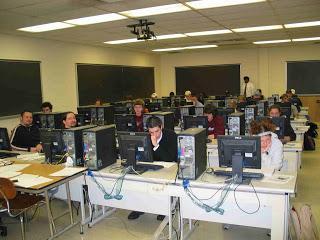


There are many, many voices offering observations and criticisms of universities in face of rising costs and tuitions. But none is more qualified than Bill Bowen to address these issues. He is the preeminent economist and analyst of the institutions of American universities, and he was a long-serving president of Princeton University. So it is a treat to read his recent set of Tanner lectures on this topic, Higher Education in the Digital Age. (The Kindle edition became available today; link.)
On the cost side, Bowen has a very clear and reasonable understanding of why university costs tend to rise more rapidly than inflation. Universities are very labor-intensive organizations, and the largest component of their workforce are highly skilled and nationally competitive faculty. But highly skilled professionals on university faculties are linked to employment markets outside of academia, and salaries in those external markets continue to rise healthily. To maintain excellence in research and teaching, universities need to increase compensation annually, and often at rates that are moderately higher than inflation. There are other cost drivers that Bowen doesn't discussed -- i.e. rising healthcare costs -- but competition for the best faculty is key. (It is unfortunate that he uses the phrase "cost disease," which implies that the rising cost structure in higher education is somehow a chronic failure within the sector, rather than an inherent feature of the nature of the work.)
Moreover, Bowen correctly notes that processes leading to productivity gain in other parts of the economy have not been possible in the teaching and research environment. Teaching undergraduates is a time-consuming activity for skilled professors, and reducing the time per student means lowering the quality of learning that occurs.
The basic idea is simple: in labor-intensive industries such as the performing arts and education, there is less opportunity than in other sectors to increase productivity by, for example, substituting capital for labor. (3)Bowen quotes Robert Frank who observed that "it still takes four musicians nine minutes to perform Beethoven's String Quartet No. 4, just as it did in the nineteenth century" (4).
To be sure, universities need to continue to improve productivity in the routine business and management of the institution, and most universities have become very adept at this effort. But the compensation costs of maintaining a nationally competitive faculty generally outweigh these savings, so the cost of instruction per student continues to rise slightly ahead of inflation. (Bowen and others estimate this premium at about one percent; 4.)
Bowen also spends some effort on analyzing "productivity" in the context of universities. Some aspects of university outcomes are easily quantified -- degrees awarded, time to degree, performance on standardized tests. But Bowen makes a key point when he observes that perhaps the most important outcome -- educational quality -- is not measurable; and yet leaders, faculty, and managers of universities must remain committed to maintaining and enhancing the quality of the education they provide. And quality has a cost. Bowen makes interesting use of a New England Journal of Medicine article on IT innovations and productivity; link. Here is a relevant publication from the National Academy Press authored by Teresa Sullivan and others, Improving Measurement of Productivity in Higher Education (link).
In order to fundamentally change the cost structure of a university education, it would be necessary to do one of two possible things: either significantly increase the number of students for whom a single faculty member is responsible (greatly increasing the student-faculty ratio), or increase the number of lower-paid instructors whose job responsibilities are more limited than the current system (full responsibility of all details of a single course, research activity, participation in departmental affairs, ...). Both of these pathways seem like significant steps away from the learning intimacy that Bowen extolls in the experience of a residential college. "Flipping the classroom" and maintaining or increasing the amount of faculty contact with students sounds like a great learning solution -- but it doesn't reduce costs.
What is most interesting about the book is the second lecture, "Prospects for an Online Fix." Since many breathless voices have started to argue that online education and MOOCs are a breakthrough technology for universities and colleges that will render the traditional classroom obsolete, Bowen's take on this question is an important one. His overall assessment is a measured one. He thinks that there is some reason to expect that blended pedagogy and curriculum may in fact be possible in ways that enhance learning and reduce the cost curve. But he also points out that there are only a limited number of rigorous studies of learning outcomes for online and face-to-face instruction, and these studies do not support a clear advantage for either modality. Essentially the most common findings are that learning outcomes are roughly similar in online and face-to-face classes. More importantly, though, he finds that there is very little rigorous research available to evaluate the possibility of cost savings through online instruction. And without significant (and growing) cost savings, the technology shift does not affect the cost curve.
So where does Bowen's current cautious optimism about online and blended instruction come from? Several things seem to have influenced him since his Romanes Lecture at Oxford in 2000, which was significantly more dubious about the prospects for cost-reducing, effective online university instruction. One is the cluster of innovations in software-based quizzing, coaching, and tutoring that have occurred in the past ten years. Another is the finding of some studies that faculty and online course designers are beginning to get the hang of how to use the online medium to greater pedagogical effect than simply placing a traditional course online with existing materials and techniques. And a third, on the learning-outcomes side, is the educational payoff that may result from "flipping the classroom" -- relieving the faculty member from lectures and using face-to-face time for discussion, coaching, and probing of learning quality.
The kinds of courses that are most frequently studied in research about online education are generally on the technical side of the curriculum: statistics, accounting, and calculus have been studied for learning outcomes by both approaches. We might imagine that entry-level courses in the sciences, engineering, and business might fall in the same general scope. But what about courses in humanities, human resources, marketing, ethnography, history, or sociology? Are there online pedagogies that would offer an effective base for learning in these fields? How can we be assured that the abstract cognitive and analytical skills associated with art history, philosophy, or computer design are actually being developed in the students who take these kinds of courses online?
Here is the vision that Bowen ultimately offers of the "university in the digital world":
Can we imagine a university in which
- Faculty collaborate more on teaching (with technology serving as the forcing function)?
- Faculty devote more of their time to promoting "active learning" by their students and are freed from much of the tedium of grading and even giving essentially the same lecture countless times?
- Students receive more, and more timely, individualized feedback on assignments?
- Instruction is guided by evidence drawn from massive amounts of data on how students learn, what mistakes students commonly make, and how misunderstandings underlying those mistakes can be corrected ("adaptive learning")?
- Technology is used to bring the perspectives of a more diverse student body onto its campus through its capacity to engage students from around the world?
- Technology extends the educational process throughout one's life through the educational equivalent of booster shots? And ideally:
- A university in which institutional costs and tuition charges rise at a slower rate? (44)
I am today a convert. I have come to believe that now is the time. Far greater access to the Internet, improvements in Internet speed, reductions in storage costs, the proliferation of increasingly sophisticated mobile devices, and other advances have combined with changing mindsets to suggest that online learning, in many of its manifestations, can lead to at least comparable learning outcomes relative to face-to-face instruction at lower-cost. (45)What is surprising to me about Bowen's current optimism is that it seems premature, given Bowen's own commitment to rigorous measures of quality and costs. As he points out repeatedly in the lecture, the high-quality studies of educational effectiveness are not yet available in sufficient volume to permit confident conclusions; and studies of the cost structure of online and blended instruction are even less detailed.
But more concerning is the issue of defining more adequately the kinds of intellectual and social maturation we most want to stimulate with an undergraduate education, and whether the pedagogies that emerge in online education are effective in creating those forms of development. It is one thing to help a student learn the central doctrines of Descartes, Hume, and Kant as a list of propositions; it is quite another to help him or her to think critically, creatively, empathetically, and innovatively about the philosophical developments and social context that stimulated these ideas about rationalism and empiricism.
A related concern is the problem of generating student engagement in learning. The best classes I have had in my career as a philosophy professor have been those in which students gained an excitement and engagement with the issues which led them to want to learn more about the subject. They wanted to discuss ideas in the class and outside the class; they were happy to be steered towards additional readings; they took on the subject matter as their own. How does this form of intellectual engagement emerge from an online class? How does the learning become personal? How does the student acquire a stake in the learning and an intellectual passion for taking it further? Bowen recognizes the importance of direct contact with professors in generating this kind of engagement (67-68); but he suggests, somehow, that this personal contact will be increasingly the province of the richer institutions. "The mix will vary by institutional type, and relatively wealthy liberal arts colleges and selective universities can be expected to offer more in-person teaching than can many less privileged institutions" (68). But what if the in-person contact is actually the secret sauce -- the ingredient that makes the recipe work?
I still remember taking the GRE in philosophy as a senior philosophy student at the University of Illinois in 1971. It struck me as being no more than a scholastic joke, probing for the student's knowledge about names and key doctrines in the history of philosophy without any real ability to assess philosophical cognitive skills. This standardized exam had nothing whatsoever to do with real philosophical thinking, or the skills of reasoning and questioning that begin to contribute to one's being a capable philosopher. I fear that online education in philosophy and other areas of the humanities would be vulnerable to exactly this fatal weakness: emphasizing facts and formal structures of doctrines, but giving short shrift to development of the critical skills that are needed to make sense of the issues in the field. Could we imagine Wittgenstein without Frege and Russell?
(Here is an excellent survey of current research on online education by Bowen and Kelly Lack; link.)
